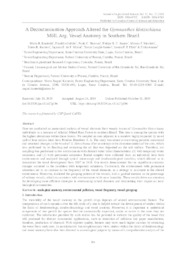A decontamination approach altered the Gymnanthes klotzschiana Müll. Arg. Vessel anatomy in Southern Brazil.
A decontamination approach altered the Gymnanthes klotzschiana Müll. Arg. Vessel anatomy in Southern Brazil.
Author(s): KANIESKI, M. R.; GALVÃO, F.; BOTOSSO, P. C.; SOARES, P. R. C.; NICOLETTI, M. F.; KONZEN, E. R.; MILANI, J. E. de F.; LONGHI-SANTOS, T.; PFUTZ, I. F. P.; AMANO, E.
Summary: Here we conducted an anatomical analysis of vessel elements from woody tissues of Gymnanthes klotzschiana individuals in a remnant of Alluvial Mixed Rain Forest in southern Brazil. This tree is among the species with the highest abundance within these forests. We sampled an area adjacent to a meadow highly impacted by an oil spill of four million liters from Petróleo Brasileiro S. A. The study was aimed at uncovering possible anatomical and structural changes in the wood of G. klotzschiana after an attempt at the decontamination of the area, which was performed by its flooding and extracting the oil that was deposited on the soil surface. Therefore, our sampling was performed in two environments with distinct water table characteristics: (1) with temporary water saturation, and (2) with permanent saturation. Radial samples were collected from an individual from both environments and analyzed through optical microscopy and dendroecological variables, which allowed us to reconstruct the wood development from 1997 to 2010. Our results demonstrated that no significant anatomic changes occurred in the condition with temporary saturation. Conversely, the environment with permanent saturation led to an increase in the frequency of the vessel elements, as a strategy to acclimate to the altered environment. Moreover, it altered the grouping pattern of the vessels, with a gradual increase in the percentage of solitary vessels, which is consistent with environments with more humidity. These results drive our attention for developing more efficient strategies to overcoming natural disasters and diminishing their impact on local biological communities.
Publication year: 2019
Types of publication: Journal article
Unit: Embrapa Forestry
Observation
Some of Embrapa's publications are published as ePub files. To read them, use or download one of the following free software options to your computer or mobile device. Android: Google Play Books; IOS: iBooks; Windows and Linux: Calibre.
Access other publications
Access the Agricultural Research Database (BDPA) to consult Embrapa's full library collection and records.
Visit Embrapa Bookstore to purchase books and other publications sold by Embrapa.

